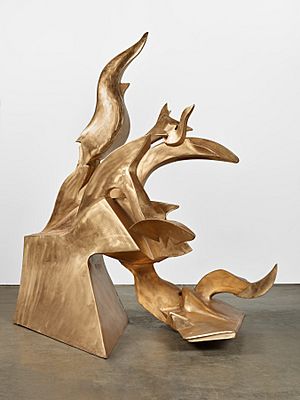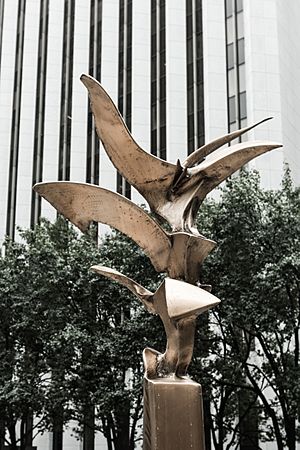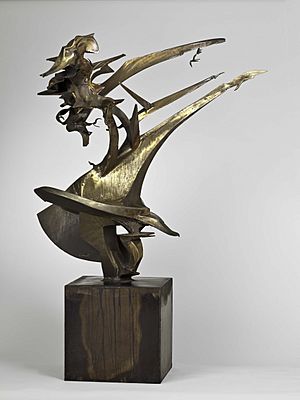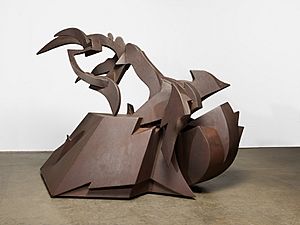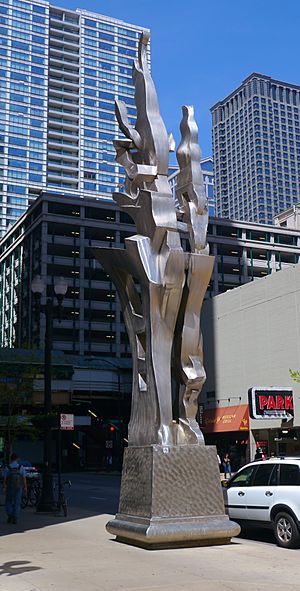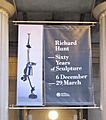Richard Hunt (sculptor) facts for kids
Quick facts for kids
Richard Hunt
|
|
|---|---|
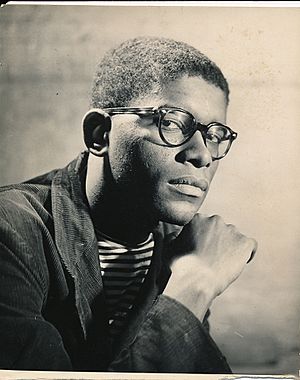
Hunt in 1962
|
|
| Born |
Richard Howard Hunt
September 12, 1935 Woodlawn, Chicago, Illinois, U.S.
|
| Died | December 16, 2023 (aged 88) Chicago, Illinois, U.S.
|
| Nationality | American |
| Education | Englewood High School |
| Alma mater | School of the Art Institute |
| Occupation | Sculptor |
| Years active | 1953–2023 |
| Known for | Sculpture, drawing, printmaking |
|
Notable work
|
|
Richard Hunt (born September 12, 1935 – died December 16, 2023) was a famous American sculptor. He became known as a leading African-American artist who created abstract sculptures and public art. Richard Hunt's family came from West Africa. He studied art at the School of the Art Institute of Chicago in the 1950s and won many awards for his work.
In 1971, he was the first African-American sculptor to have a special show of his work at the Museum of Modern Art in New York. Hunt created over 160 public sculptures, which are artworks placed in public spaces. This is more than any other sculptor in the United States. His art can be found in 24 states.
Richard Hunt's career lasted for seventy years. He had over 150 solo art shows. His work is also in more than 100 museums around the world. His modern and abstract sculptures were shown in exhibitions and public places starting in the 1950s. Former President Barack Obama said in 2022 that Richard Hunt was "one of the greatest artists Chicago has ever produced."
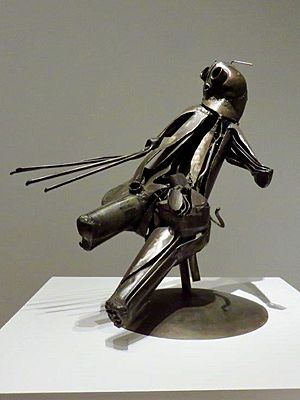
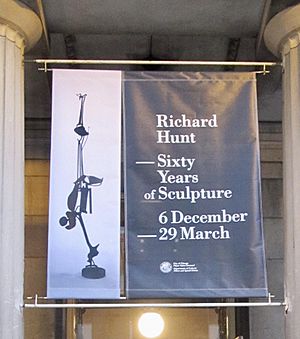
Contents
- Early Life and Art
- Education and Artistic Style
- European Travel and Military Service
- Museum of Modern Art and Career Highlights
- National Endowment for the Arts
- Sculptures for Heroes
- Obama Presidential Center Commission
- Richard Hunt's Thoughts on Art
- Selected Awards and Honors
- Honorary Degrees
- Selected Works
- Selected Public Collections
- Images for kids
- See also
Early Life and Art
Richard Hunt was born in 1935 in Chicago's Woodlawn neighborhood. He and his younger sister, Marian, grew up there. Even though he moved to Galesburg, Illinois, at age eleven, he spent most of his life in Chicago. From a young age, he loved art.
His mother, who was a beautician and librarian, took him to see local opera shows. He enjoyed music by famous composers like Mozart and Verdi. As a boy, Hunt showed a lot of interest and skill in drawing, painting, and sculpting. His parents supported his artistic dreams. He said, "My mom was supportive and dad was tolerant."
When he was in seventh grade, Hunt went to the Junior School of Art Institute of Chicago. He also learned about business and social issues by working in his father's barbershop.
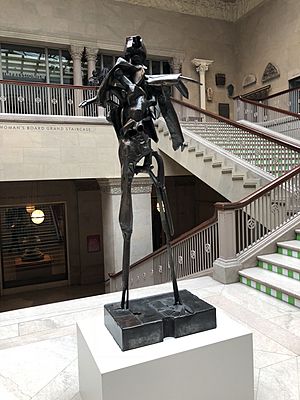
Starting Sculpture
As a teenager, Hunt began making sculptures. He worked with clay, carved wood, and used a material called Sculpt-Metal. He started in his bedroom, then built a studio in his father's barbershop basement. Later, he had a studio in the basement of his family's home in Englewood.
Education and Artistic Style
Hunt finished Englewood High School early in January 1953. He then started at the School of the Art Institute of Chicago later that year. At the Art Institute, Hunt first focused on making figures from soldered wire. Then he moved on to welding sculptures. He also created lithographs, which are a type of printmaking.
He was interested in Modernism, Abstract Expressionism, and Surrealism. He liked to experiment by putting together broken machine parts, car bumpers, and metals from junkyards. He reshaped these into natural-looking forms. Hunt later worked with iron, steel, copper, and aluminum. He made a series of "hybrid figures" that looked like a mix of human, animal, and plant shapes.
Hunt explored how natural and industrial things could work together in his art. His earliest works often showed classical themes and were more like real figures than his later ones. He started showing his sculptures across the country while still a student. The Museum of Modern Art in New York bought his piece "Arachne" when he was still a junior. He earned his bachelor's degree in art education in 1957.
European Travel and Military Service
After graduating, Hunt received a special scholarship called the James Nelson Raymond Foreign Travel Fellowship. He sailed to England and then to Paris. He rented a car to travel through Spain, Italy, and back to Paris. He spent most of his time in Florence, Italy. There, he learned how to cast his first sculptures in bronze at a famous foundry. His time in Europe made him believe that metal was the most important material for art in the 20th century.
Serving in the Army
Hunt served in the United States Army from 1958 to 1960. He worked as an illustrator for a medical center. While he was stationed in Texas, Hunt rented a new house on the army base. He was the first African American to live in that neighborhood, helping to end segregation there.
Helping with Desegregation
In 1960, Mary Andrews, who led a youth group of the NAACP, asked stores in San Antonio, Texas, to serve all customers equally. On March 16, 1960, Hunt, wearing his Army uniform, went to eat at Woolworth's. He was served without any problems. Hunt was one of the first African Americans to eat at a segregated lunch counter in San Antonio that day. This action, along with others, helped San Antonio become the first city in the South to peacefully end lunch counter segregation.
Museum of Modern Art and Career Highlights
Richard Hunt's art has been shown 12 times at the Museum of Modern Art (MoMA) in New York. In 1971, when he was only 35 years old, MoMA held a major solo show of his work. It was called "The Sculpture of Richard Hunt." This made him the first African American sculptor to have such a show at MoMA. It was only the second time MoMA had a show for a Black artist of any kind.
Developing His Style
Hunt started trying out different materials and sculpting methods. He was greatly influenced by modern artists of the 20th century. He was inspired to focus on sculpture after seeing an exhibition called "Sculpture of the Twentieth Century" in Chicago in 1953. This show included works by Pablo Picasso and David Smith. At the exhibition, Hunt saw welded metal artworks for the first time. He was also inspired by the French sculptor Raymond Duchamp-Villon.
Seeing these works taught Hunt how to solder wire to make small figures. Later, in 1955, he learned to weld metal. He then created both figures and abstract shapes.
In the 1960s and 1970s, Hunt found materials in car junkyards. He turned car bumpers and fenders into abstract, welded sculptures. He also focused on arranging his materials in lines and spaces, following the ideas of Julio González. The art world praised his experiments. His work was shown in important exhibitions, and the Museum of Modern Art bought one of his pieces. He was the youngest artist to show his work at the 1962 Seattle World's Fair, a big international art show.
Public Art Commissions
Hunt received his first public sculpture project in 1967. This sculpture, called Play, was for the State of Illinois Public Art Program. Making this piece led him to many other public art projects, which became a major part of his career. He completed more public sculptures than any other artist in the country.
Some of his well-known public works include Jacob's Ladder at the Carter G. Woodson Library in Chicago and Flintlock Fantasy in Detroit. His 1972 sculpture, Natural Forms II, is at the Delaware Art Museum.
Leadership Roles
President Lyndon Johnson chose Hunt to be one of the first artists on the board of the National Endowment for the Arts. He also served on boards for the Smithsonian Institution. From 1980 to 1988, Hunt was a Commissioner for the Smithsonian Institution's National Museum of American Art. From 1994 to 1997, he served on the Smithsonian Institution's National Board of Directors. Hunt received many awards and honorary degrees throughout his life.
In 1971, Hunt bought an old electrical power station in Chicago. He turned it into his metal welding sculpture studio. The building had a large crane, which was helpful for moving big sculptures. It also had a high 40-foot ceiling. Hunt worked with two assistants to handle the metal. He described metalwork as "free play of forms evolving, developing and contrasting with one another."
Hunt kept trying new sculpting methods throughout his career. Through his art, Hunt often shared his views and quietly commented on current social and political issues.
National Endowment for the Arts
Richard Hunt was the first African American visual artist to serve on the National Council on the Arts. This is the main group for the National Endowment for the Arts. President Lyndon B. Johnson appointed him in 1968. He was the fourth African American on the council, after Marian Anderson, Ralph Ellison, and Duke Ellington.
Sculptures for Heroes
Hunt created large sculptures and monuments for some of America's most important heroes. These include Martin Luther King, Jr., Mary McLeod Bethune, Jesse Owens, and Ida B. Wells. His huge 30-foot-wide bronze sculpture, “Swing Low,” (2016) hangs from the ceiling of the National Museum of African American History and Culture. It is a tribute to African American spiritual songs. Since 2017, another of Hunt's welded sculptures, “Hero Construction,” (1958) is a main artwork at The Art Institute of Chicago.
Obama Presidential Center Commission
On February 26, 2022, the Obama Foundation announced that Richard Hunt would create a sculpture called "Book Bird" for the Barack Obama Presidential Center. This sculpture is based on a piece Hunt made as an award for supporters of the United Negro College Fund.
The Obama Foundation said, "This beautiful piece shows the progress you can make through reading. It embodies the inspiration we hope all young people feel when they visit the Obama Presidential Center." President Barack Obama told Richard Hunt, “I’ve been a huge admirer of your work for a long time, and Michelle has as well.”
Richard Hunt's Thoughts on Art
Richard Hunt shared many thoughts about his art and life:
- He wanted his sculptures to look like what nature might create if it only had heat and steel.
- He believed that everything, whether natural or made by humans, has some sculptural quality.
- One of his main ideas was to bring together natural and industrial forms in his work.
- He wanted to leave physical proof that he and his family had lived on Earth.
- He imagined a world without racial differences and worked as if race did not exist.
- He saw his sculpture not just as his own statement, but as a voice for his people.
- He was always interested in the idea of freedom, both for individuals and for everyone. This included political freedom and the freedom to think and feel.
- Issues like segregation laws and the Civil Rights movement were on his mind when he thought about freedom.
- His use of winged shapes in his early work was based on myths like Icarus and Winged Victory. These forms represent trying to achieve victory or freedom. They also connect to the African-American experience and are a universal symbol.
Selected Awards and Honors
Richard Hunt received many important awards and honors throughout his career:
- 1956: Mr and Mrs. Frank G. Logan Medal and Prize, Art Institute of Chicago
- 1957: James Nelson Raymond Traveling Fellowship, School of the Art Institute of Chicago
- 1957: Pauline Palmer Prize, Art Institute of Chicago
- 1961: Mr and Mrs. Frank G. Logan Medal and Prize, Art Institute of Chicago
- 1962: Mr and Mrs. Frank G. Logan Medal and Prize, Art Institute of Chicago
- 1962: Walter M. Campana Prize, Art Institute of Chicago
- 1962-63: John Simon Guggenheim Memorial Foundation Fellowship
- 1965: Tamarind Artist Fellowship, Ford Foundation
- 1970: Award, Cassandra Foundation
- 1980: James Van Der Zee Lifetime Achievement Award, Brandywine Workshop and Archives
- 1990: Sidney R. Yates Art Advocacy Award, Illinois Arts Alliance Foundation
- 1993: Laureate, Lincoln Academy of Illinois
- 1997: Artists Award, The Studio Museum in Harlem
- 1998: Distinguished Artist, The Union League Club of Chicago
- 1998: Member, American Academy of Arts and Letters
- 1999: Chicago African American History Maker Award, The DuSable Museum of African American History, Chicago
- 1999: Member, National Academy of Design
- 2003: Harry W. Watrous Prize and Elizabeth N. Watrous Medal, National Academy of Design
- 2004: Archibald Motley Jr. History Maker Award for Distinction in Visual Arts, Chicago History Museum
- 2005: Malvina Hoffman Artists Fund Award, National Academy of Design
- 2009: Charlotte Dunwiddie Prize, National Academy of Design
- 2009: Lifetime Achievement Award, International Sculpture Center
- 2010: Legacy Award, United Negro College Fund
- 2011: Ruth Horwich Award to a Famous Chicago Artist, City of Chicago Department of Cultural Affairs
- 2014: Fifth Star Award, City of Chicago
- 2014: Lifetime Achievement Award, Howard University
- 2015: Alain Locke International Art Award, Detroit Institute of Arts
- 2015: Lifetime Achievement Award, Partners for Livable Communities
- 2017: Legendary Landmark's Honoree, Landmarks Illinois
- 2022: Legends and Legacy Award, Art Institute of Chicago
- 2022: Richard Hunt Day proclaimed by Mayor Lori Lightfoot, City of Chicago, June 10
- 2023: Chicago Public Library Foundation Arts Award
- 2023: Dorsky Lifetime Achievement Award, Samuel Dorsky Museum of Art
- 2023: Music of the Baroque Honoree, Chicago
- 2023: Richard Hunt Day proclaimed by Governor J.B. Pritzker, State of Illinois, April 24
Honorary Degrees
Richard Hunt also received honorary degrees from many universities:
- 1972: Lake Forest College, Lake Forest, IL
- 1973: Dayton Art Institute, Dayton, OH
- 1976: University of Michigan, Ann Arbor
- 1977: Illinois State University, Normal
- 1979: Colorado State University, Fort Collins
- 1982: School of the Art Institute of Chicago
- 1984: Northwestern University, Evanston, IL
- 1986: Monmouth College, Monmouth, IL
- 1987: Roosevelt University, Chicago
- 1991: Tufts University, Medford, MA
- 1996: Columbia College, Chicago
- 1997: Governors State University, University Park, IL
- 2004: North Carolina A&T State University, Greensboro
- 2007: University of Notre Dame, Notre Dame, IN
- 2013: Valparaiso University, Valparaiso, IN
- 2022: Southern Illinois University, Carbondale
- 2023: University of Southern Indiana, Evansville IN
Selected Works
Some of Richard Hunt's notable sculptures include:
- Hero Construction (1958), Chicago, IL
- A Bridge Across and Beyond (1978), Washington, D.C.
- Wing Generator (1980) University of Notre Dame, Indiana
- Symbiosis (c. 1981), Washington, D.C.
- Build-Grow (1986), Jamaica, Queens, New York
- Build-Grow (1992), Washington, D.C.
- Swing Low (2016), Washington, D.C.
Selected Public Collections
Richard Hunt's works are held in many public art collections, including:
- Albright-Knox Art Gallery, Buffalo, NY
- Allen Memorial Art Museum, Oberlin College, Oberlin, OH
- Amon Carter Museum of American Art, Fort Worth
- Art Institute of Chicago
- Baltimore Museum of Art
- Brooklyn Museum, Brooklyn, NY
- Cincinnati Art Museum, Cincinnati, OH
- The Cleveland Museum of Art, Cleveland, OH
- Denver Art Museum
- Detroit Institute of Arts
- The DuSable Museum of African American History, Chicago
- High Museum of Art, Atlanta
- Hirshhorn Museum and Sculpture Garden, Smithsonian Institution, Washington, DC
- Indianapolis Museum of Art
- The Israel Museum, Jerusalem
- Los Angeles County Museum of Art
- The Metropolitan Museum of Art, New York
- Milwaukee Art Museum
- Minneapolis Institute of Art, Minneapolis, MN
- Museum of Contemporary Art Chicago
- Museum of Fine Arts, Boston
- Museum of Fine Arts, Houston
- The Museum of Modern Art, New York
- National Gallery of Art, Washington, DC
- National Museum of African American History and Culture, Washington, DC
- The Nelson-Atkins Museum of Art, Kansas City, MO
- Pennsylvania Academy of the Fine Arts, Philadelphia
- Philadelphia Museum of Art
- Portland Art Museum, Portland, OR
- Princeton University Art Museum, Princeton, NJ
- RISD Museum, Rhode Island School of Design, Providence
- Smithsonian American Art Museum, Washington, DC
- Storm King Art Center, Mountainville, NY
- The Studio Museum in Harlem, New York
- Whitney Museum of American Art, New York
- Yale University Art Gallery, New Haven, CT
Images for kids
See also
 In Spanish: Richard Hunt (escultor) para niños
In Spanish: Richard Hunt (escultor) para niños


